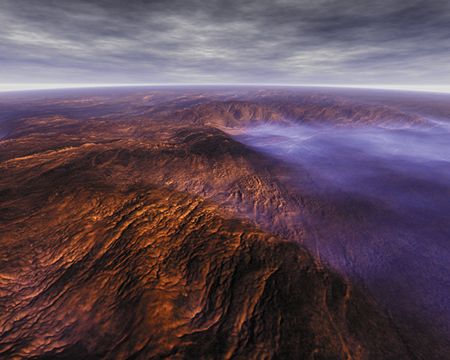

Venus Data
- Average distance from the Sun: 0.72 x Earth distance
- Orbital period: 225 days
- Diameter: 0.95 x Earth diameter
- Mass: 0.82 x Earth mass
- Rotation period: 243 days
- Average density: 5.24 g/cm3
- Composition: rocky (including both rock and metal)
- Average surface temperature: 470°C
- Moons: 0
We find the second planet from the Sun, Venus, just a few steps beyond Mercury in our model. Because Venus and the Earth are nearly identical in size–both pinheads in the model solar system–Venus is sometimes called our sister planet.
Venus is covered in dense clouds, and because it is not much closer to the Sun than the Earth science fiction writers once speculated that Venus might be a lush, tropical paradise. We now know that an extreme greenhouse effect bakes its surface to an incredible 470°C (about 880°F) and traps heat so effectively that nighttime offers no relief–day and night, Venus is hotter than a pizza oven. All the while, the thick atmosphere bears down on the surface with a pressure equivalent to that nearly a kilometer (0.6 mile) beneath the ocean surface on Earth.
Besides the crushing pressure and searing temperature, a visitor to Venus would feel the corrosive effects of sulfuric acid and other toxic chemicals in its atmosphere. Far from being a beautiful sister planet to Earth, Venus resembles a traditional view of hell.
Angular size activity (for those on an actual tour of a Voyage model): As you did at Mercury, hold up your thumb at arm’s length and compare it to the size of the model Sun as it appears from the model Venus’s location. Has the angular size of your thumb (at arm’s length) changed? Has the angular size of the model Sun changed? Explain what is happening.
